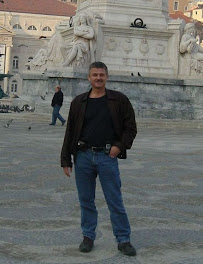Sunday, October 28, 2012
Back on Baclofen
I'm back to trying Baclofen, starting with a very low dose for a couple of weeks to let my body get used to it. I'm not feeling the dizziness I felt the first time I tried it, but I may also be getting less restful sleep... I'll keep you informed as time goes on.
New York Times Article: CCSVI Controversy
Here's a fairly long NY Times article on CCSVI: A Controversial ‘Cure’ for M.S. Since there really isn't anyone calling it a "cure" for MS, I wonder why they used that title?
Sunday, October 21, 2012
Fampyra didn't work for me
Unfortunately, I am in the 66% of MSers who get no (obvious) mobility benefit from Fampyra... *sigh*... Oh well, maybe something else will come long.
Thursday, October 11, 2012
Dr. Dake Pays the Price
It looks like Dr. Dake (and Stanford) are being sued by two patients who had the "liberation" treatment: WSJ article. It's interesting that this is in "Market Watch" section of the WSJ. If the allegations are true, then it would seem that Dr. Dake placed multiple stents in a patient who explicitly stated he didn't want any. Thanks to Ken Torbert, again, for leading me to this story.
Tuesday, October 9, 2012
Expert and Patient Opinions about CCSVI
Thanks to Ken Torbert of CCSVI Locator for passing on this link to the current opinions of various experts and MS patients gathered by CCSVI Australia: CCSVI Australia web page.
Tuesday, October 2, 2012
System model of MS
Here is an intriguing model of MS causation and progression developed by using a systems approach to analyzing over 700 papers on the subject: research article. Interesting that it was undertaken by a multi-disciplinary team of medical and engineering (physics, systems chemical) researchers. My friend Dave had once said that this complex thing called MS needs to be looked at in a cross-disciplinary way... and research like this may well prove him right. Certainly the authours of this article feel that this kind of approach is necessary.
For those who don't want to read the whole article, the following suggestions come from their study of the MS systems model (unfortunately, their paper could have done with some editing and proof-reading):
Since there is a strong element of food allergy at the root of multiple sclerosis, that does not imply that (?) We suggest here several main lines of treatment in the strategy:
1. Stop triggers and provocative toxins: a. Remove all gluten, dairy products and legumes from the diet. b. Until proper blood flow has been restored; i. Avoid going to high elevations, exhaustion that may bring down blood oxygen concentrations ii. Avoid exercises that may increase the risk of overheating the brain. iii. Avoid warm climates and any environments with temperatures above 27oC. c. Stop provoking infections: Terminate any ongoing triggering infections in the upper respiratory tract or sinuses by boosting the immune system with food containing vitamins and minerals that support the immune system and/or take relevant vitamins – and/or administer relevant antibiotic drugs.
2. Cut feedback loops: a. Get treatment for any constricted blood vessels, invasive or other method, in order to restore proper blood-flow for draining the brain and spinal cord of returning blood. This implies invasive treatment to eliminate chronic cerebro-spinal vascular insufficiency (CCSVI). b. Elimination of free radicals through vitamin and antioxidant therapy in order to prevent weakening of vessel walls, and disruption of antibody programming. Strengthening the myelin sheath repair mechanisms with essential nutrients like omega 3 for healing c. Immuno-regulating medication to break off the vicious autoimmune circle acting on oligodendrocytes and myelin sheaths, for example with interferon-! type short term intensive treatment.
3. Rebuild damaged structures: a. Strengthening of regenerative mechanisms (oligodendrocytes), through the necessary resources demanded (e.g. omega 3 and?) as well as growth factors that can be included in the diet. b. Prevent further BBB opening substances by filling the BBB membranes with flavonoids that prevent adsorption of foreign substances. The flavonoids from blueberries, blackberries and blackcurrants are most effective.
4. Remove risk factors a. Avoid all high histamine diets (Certain types of wine, fermented foods, old fish etc) b. Avoid heavy metal exposure of any kind c. Eliminate any unnecessary microwave radiation as it is suspected to be able to compromise the blood-brain barrier and smaller venous blood vessels.
Monday, October 1, 2012
CCSVI clinical trials: So why is everyone so pissed off?
Another good story from Ann Kingston... and check out the comments, as well: Maclean's article.
Subscribe to:
Posts (Atom)



